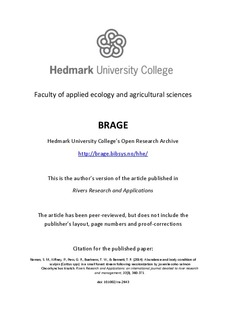Abundance and body condition of sculpin (Cottus spp.) in a small forest stream following recolonization by juvenile Coho Salmon (Oncorynchus kisutch)
Journal article, Peer reviewed
Permanent lenke
http://hdl.handle.net/11250/277891Utgivelsesdato
2014Metadata
Vis full innførselSamlinger
Originalversjon
Naman, S. M., Kiffney, P., Pess, G. R., Buehrens, T. W., & Bennett, T. R. (2014). Abundance and body condition of sculpin (Cottus spp.) in a small forest stream following recolonization by juvenile coho salmon Oncorhynchus kisutch. Rivers Research and Applications: an international journal devoted to river research and management, 30(3), 360-371. doi: 10.1002/rra.2643 10.1002/rra.2643Sammendrag
Recolonization by native species following reintroduction can affect resident species through a variety of processes. We examined the effects of natural recolonization by coho salmon Oncorhynchus kisutch on sculpin (Cottus rhotus and Cottus gulosus), small benthic fishes, in a small forest stream in Western Washington, USA. Provision fish passage around a small dam allowed coho access to habitat, which had been inaccessible for over 100 years. We found that density (g m−2 and number m−2) was unchanged, and body condition (the slope of the relationship between length and weight) of sculpin tended to increase from before relative to a 5-year period following recolonization. The proportion of sculpin comprising the total fish assemblage decreased after coho colonization relative to before but remained stable for a 5-year period after coho reintroduction, whereas coho density increased over fivefold. Additionally, we used Akaike's information criteria to evaluate the relative importance of physical and biological variables to predict sculpin density in pool habitats during the initial coho recolonization period. Physical microhabitat variables had little support for predicting sculpin density, whereas there was a significant support for stream temperature; cutthroat trout (Oncorhynchus clarkii) density and year were the most important predictors of sculpin density. Coho density was not significant in any model. Our results indicate coho introduction and subsequent recolonization have to date had minimal individual or population level effects on sculpin, therefore demonstrating that species reintroductions into their native range can have no measurable effect on resident organisms. Published 2013. This article is a U.S. Government work and is in the public domain in the USA.
